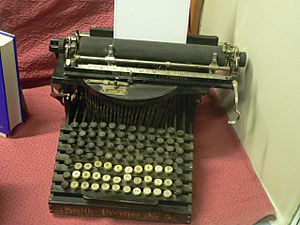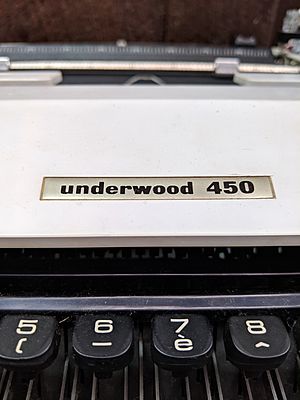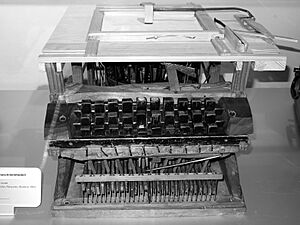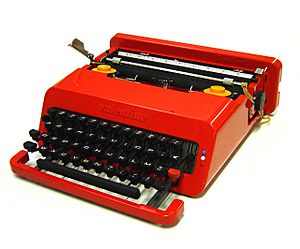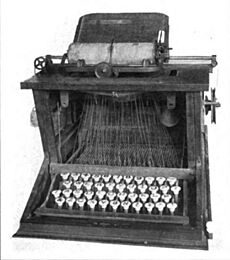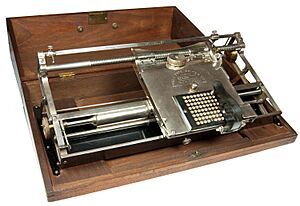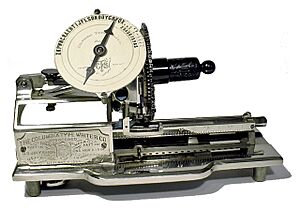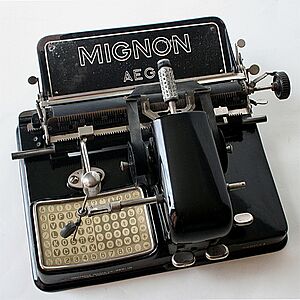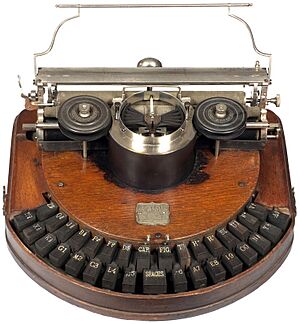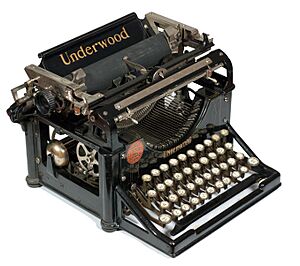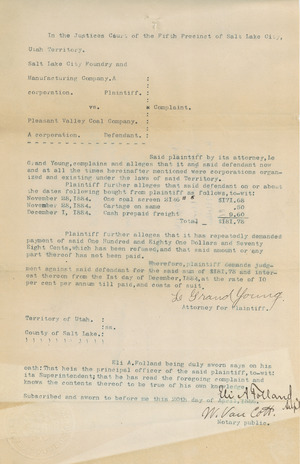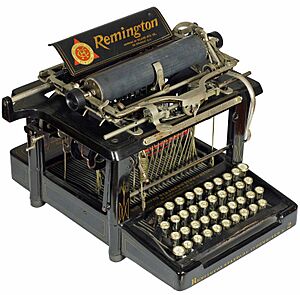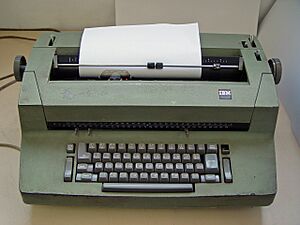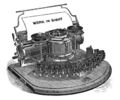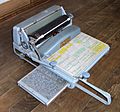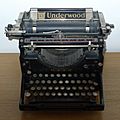Typewriter facts for kids
A typewriter is a machine that helps you type letters and words onto paper. It can be a mechanical machine, meaning you power it yourself, or an electromechanical one, which uses electricity.
Imagine a keyboard with many keys. When you press a key, a small metal piece with a letter on it (called a type element) hits an inked ribbon. This ribbon then presses against the paper, leaving a clear mark of the letter. This way, you create a neat, written document. By the late 1800s, the person using this machine was also called a "typewriter."
Unlike computers, typewriters don't have memory. If you make a mistake, it's tricky to fix, much like writing with a pen. But they have some cool benefits! Many don't need to be plugged in, so you can use them anywhere. Also, hackers can't see what you're typing, which means your work stays private. The first typewriters were sold in 1874, but they became really popular in offices after the mid-1880s.
Typewriters quickly became super important for almost all writing, except for personal handwritten letters. Writers, office workers, and businesses used them a lot. They were common in most offices until the 1980s, when computers started to take over. Still, some people today use typewriters for special tasks or just for fun! Early typewriters were "manual," meaning you did all the work. Later, electric typewriters with a motor became more common.
Contents
How Did Typewriters Start?
Many people helped invent the typewriter over many years. It wasn't just one person! Historians believe that some form of a typing machine was invented about 52 times as people tried to create a working design.
Here are some early ideas for typing machines:
- In 1575, an Italian printer named Francesco Rampazetto made a machine to press letters onto paper.
- In 1714, Henry Mill in Britain got a patent for a machine that seemed like a typewriter. It was meant to make writing neat and hard to erase.
- In the early 1800s, Italians like Agostino Fantoni and Pellegrino Turri made typewriters to help blind people write.
- In 1829, William Austin Burt from America patented a machine called the "Typographer." Some say it was the first typewriter, but earlier inventions existed.
By the mid-1800s, businesses needed to write faster. People could speak or take notes very quickly, but writing by hand was slow (about 30 words per minute). This created a need for machines to speed up writing.
From 1829 to 1870, many typing machines were patented, but none were sold widely.
- Charles Thurber created machines to help blind people in the 1840s.
- In 1855, Giuseppe Ravizza in Italy made a prototype that let the user see what they were typing as they wrote.
- In 1861, Father Francisco João de Azevedo, a priest from Brazil, built a typewriter using simple tools. He even won a gold medal for it!
- In 1865, John Pratt in the US built a machine called the Pterotype, which inspired other inventors.
- Between 1864 and 1867, Peter Mitterhofer from Austria developed several working typewriter models.
The Hansen Writing Ball
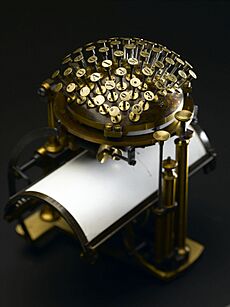
In 1865, a Danish inventor named Rev. Rasmus Malling-Hansen created the Hansen Writing Ball. This was the first typewriter sold to the public, starting in 1870. It was very popular in Europe and was used in offices even until 1909.
Some of Malling-Hansen's models used electricity to move the paper carriage, making him a possible inventor of the first "electric" typewriter. The Writing Ball only typed in capital letters. Malling-Hansen kept improving his design, and by 1875, he made a version that didn't need electricity. He won awards for his invention at big exhibitions in Vienna (1873) and Paris (1878).
The Sholes and Glidden Typewriter
The first typewriter that became a big success was patented in 1868 by Americans Christopher Latham Sholes, Frank Haven Hall, Carlos Glidden, and Samuel W. Soule. They worked in Milwaukee, Wisconsin. Sholes later didn't want to be associated with the machine.
Hall, Glidden, and Soule sold their patent to Sholes and James Densmore. They then teamed up with E. Remington and Sons, a company famous for making sewing machines, to sell the machine. They called it the Sholes and Glidden Type-Writer, which is where the word "typewriter" came from!
Remington started making these typewriters on March 1, 1873, in New York. This machine had the QWERTY keyboard layout, which you still see on most keyboards today. Because this typewriter was so successful, other companies started using the QWERTY layout too. On these early typewriters, you couldn't see what you were typing right away because the letters hit the paper from underneath.
Index Typewriters
Index typewriters appeared in the early 1880s. To use one, you would point to a letter on an index (like a dial or chart). This pointer was connected to the machine, so when you chose a letter, it would then be printed, usually by pressing a lever.
These typewriters were slower than keyboard machines, but they were simpler and lighter. This made them good for travelers or for people who only needed to type a little bit and wanted a cheaper machine. For example, the Simplex Typewriter Company made index typewriters that cost 40 times less than a Remington!
However, index typewriters soon became less popular. New keyboard typewriters became lighter and cheaper, and used machines were also available. The last well-known index typewriter in the West was the Mignon, made until 1934. It was special because you could change the index and the type, allowing for different fonts and characters.
Even though keyboard typewriters took over in most parts of the world, successful Japanese and Chinese typewriters are still index typewriters. They have a much larger index and many more characters. Today, the most common index typewriters are the machines that make embossing tape labels.
Other Important Typewriters
- 1884 – Hammond "Ideal" typewriter: This machine had a unique curved keyboard but became popular because it printed very well and you could change the typefaces. It was invented by James Hammond in 1880.
- 1888 – Fitch typewriter: Early typewriters made you type "blind," meaning you couldn't see your words until you moved the paper. The Fitch was one of the first machines where you could see what you were typing right away, making it easier to correct mistakes.
- 1893 – Gardner typewriter: This typewriter was designed to be smaller and cheaper. It had only 14 keys but could print 84 different symbols by using special "change-case" keys.
- 1896 – Underwood 1 typewriter: This was a very important typewriter because it was the first to let the typist see the typing area completely as they worked. This feature was copied by almost all typewriters that came after it. It also had a light and fast typing action.
How Typewriters Became Standard
By about 1910, manual typewriters had a pretty standard design. Most had keys connected to "typebars" that had the letter shaped in reverse on their end. When you pressed a key, the typebar would hit an inked ribbon, making a mark on the paper wrapped around a cylinder called a "platen."
The platen moved to the left after each character, automatically moving the typing position. To start a new line, you would push a lever to return the platen to the right and move the paper up. A small bell would ring near the end of a line to tell you to finish your word and start a new line. Typewriters for languages written from right-to-left worked in the opposite way.
By 1900, many big companies made typewriters, including E. Remington and Sons, IBM, Olivetti, and Underwood Typewriter Company. Later, companies from Asia like Brother Industries also became strong competitors.
Seeing What You Type (Frontstriking)
On many early typewriters, the typebars hit the paper from underneath, so you couldn't see what you were typing until you moved the paper up. It was tricky to make the typebars fall back into place correctly.
Eventually, clever designs allowed for "visible typewriters." These used "frontstriking," where the typebars hit the front of the paper. This became the standard. The Daugherty Visible, introduced in 1893, was one of the first. The Underwood, which came out two years later, was the first major typewriter with these features and a standard four-row keyboard.
The Shift Key
A very important invention was the shift key, first seen on the Remington No. 2 in 1878. This key would physically move either the group of typebars or the paper carriage. This meant that each typebar could print two different characters.
The most obvious use was for typing both capital and lowercase letters. But it also allowed number keys to have special symbols like percent (%) or ampersand (&). Before the shift key, typewriters needed a separate key for every capital letter, almost like having two keyboards! The shift key made typewriters much cheaper to make and easier to use, which helped many more people buy them.
The Tab Key
To make typewriters better for business, a tab (or tabulator) key was added in the late 1800s. Before using it, you had to set mechanical "tab stops" at specific places. When you pressed the tab key, the paper carriage would jump to the next tab stop. This made it much easier to type columns of numbers without having to move the carriage by hand.
"Noiseless" Typewriters
The first typewriter with quiet, sliding type bars was the American-made Rapid, which appeared in 1890. This machine also let the typist control the paper carriage completely from the keyboard. There were "Lift" and "Return" keys that moved the paper up and brought the carriage back, so you didn't have to take your hands off the keyboard.
In the early 1900s, a typewriter called "Noiseless" was sold and advertised as "silent." It was invented by Wellington Parker Kidder. Noiseless portable typewriters were popular in the 1930s and 1940s. These typewriters had a special system that slowed down the typebar before it hit the paper, trying to make less noise.
Why Typewriters Became Less Common
The rise of computers in the late 1900s started the end for typewriters. Computers offered many great things that typewriters couldn't, like easily editing text, saving documents on the computer, and printing many copies quickly. By the 1990s, the typewriter industry had shrunk a lot.
However, in the early 2000s, some groups of people became interested in typewriters again. This includes people who like to make things, fans of steampunk (a style inspired by old machines), and street poets.
Fun Facts About Typewriters
- The first typewriters were sold in 1874, but they didn't become common in US offices until after the mid-1880s.
- The first electric typewriter made in large numbers was the Cahill in 1900.
- James Fields Smathers invented what is thought to be the first practical power-operated typewriter in 1914.
- The last big change for typewriters was the electronic typewriter. Most of these used a "daisy wheel" (a disk with letters on its edges) instead of a typeball.
- In November 2012, the Brother factory in the UK made what they said was the very last typewriter produced in the UK. They gave it to the London Science Museum.
- Jack Kerouac, a very fast typist, typed his 1957 novel On the Road on a long roll of paper. This way, he didn't have to stop to change pages. He typed a 120-foot-long paragraph in just two weeks!
- J. R. R. Tolkien often typed in strange positions, like balancing his typewriter on his attic bed because his desk was too small.
Images for kids
-
The Hansen Writing Ball, 1870 model.
-
The personal typewriter of Mozaffar ad-Din Shah Qajar, a Persian king, from the late 1800s.
Related pages
See also
 In Spanish: Máquina de escribir para niños
In Spanish: Máquina de escribir para niños


